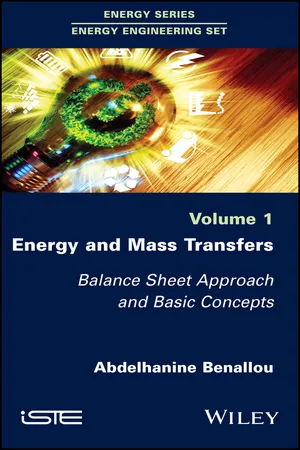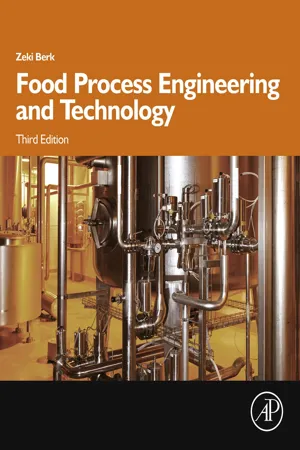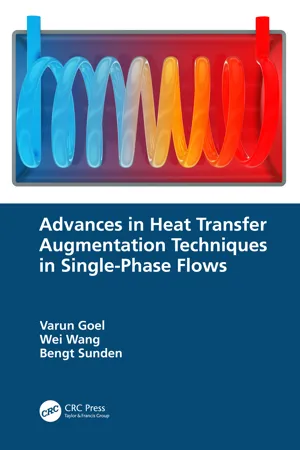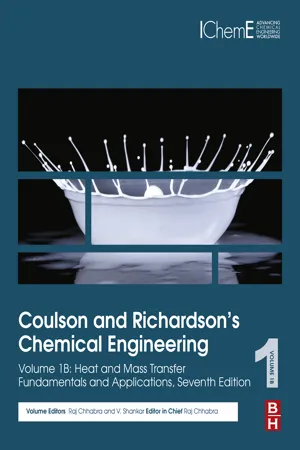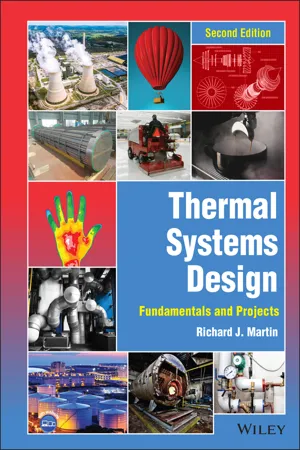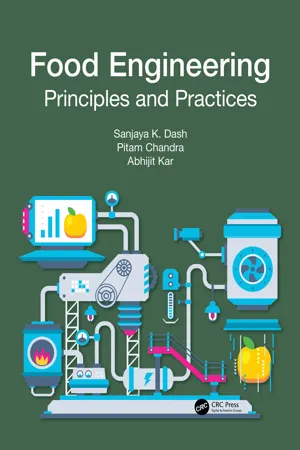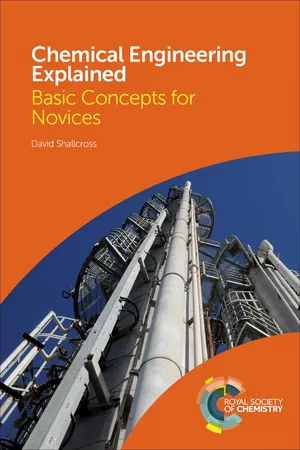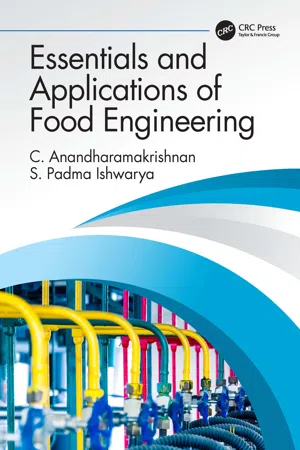Physics
Heat Transfer Experiments
Heat transfer experiments involve studying the movement of thermal energy from one object to another. These experiments aim to understand the principles of conduction, convection, and radiation. By observing how heat is transferred through different materials and mediums, scientists can gain insights into the behavior of thermal energy and its effects on various substances.
Written by Perlego with AI-assistance
Related key terms
Related key terms
1 of 4
Related key terms
1 of 3
9 Key excerpts on "Heat Transfer Experiments"
- eBook - ePub
Energy and Mass Transfers
Balance Sheet Approach and Basic Concepts
- Abdelhanine Benallou(Author)
- 2018(Publication Date)
- Wiley-ISTE(Publisher)
2 Mechanisms and Laws of Heat Transfer2.1. IntroductionThe heat fluxes transferred between systems, or between parts of the same system, are governed by a set of equations which take into account the thermal potential difference (TPD), the importance of the transfer areas concerned and the physicochemical properties of the examined flows or solids.These equations are known as heat transfer laws. They make it possible to evaluate the energy fluxes and the flux densities involved in a given heat exchange. They also make it possible to determine the temperature profiles in the systems studied.In this chapter, we analyze the different physical processes through which heat transfer occurs. This analysis is conducted with a view to elaborating the equations and laws expressing the heat fluxes induced by the different transfer mechanisms.
We already know that heat can spread according to three physical mechanisms or modes of transfer: conduction, convection and radiation.2.2. Mechanism and law of conductionIn conduction, energy exchange occurs through contact-continuity between the mass particles; the particles directly in contact with heat get excited and transmit this excitation through their contact with adjacent particles.Consider, for example, the case of a metal bar heated at one end by an electrical resistance (see Figure 2.1 ).Mass particles that are in direct contact with the electrical resistance (end 1) receive a significant amount of heat.Figure 2.1 .Conduction transferThis energy supply induces an excitation of the different particles - eBook - ePub
- Zeki Berk(Author)
- 2018(Publication Date)
- Academic Press(Publisher)
Chapter 3Heat and mass transfer, basic principles
Abstract
Transport of heat and material occurs in every process. Heat transfer and mass transfer are closely related and obey the same type of physical laws: Fourier's law for heat and Fick's law for mass. Heat is transferred by conduction, convection, and radiation. In the absence of agitation, heat is transferred by conduction, and mass by molecular diffusion. Thermal conductivity and molecular diffusivity are properties of the material. The laws of steady- and unsteady-state transfer are developed and illustrated with the help of typical examples.Heat exchangers are extensively used in industry for the interchange of heat between fluids. The different types of heat exchangers are described and their specific characteristics are analyzed. A section each is devoted to microwave and ohmic heating.Keywords
Fourier's and Fick's laws; Conduction; Thermal conductivity; Molecular diffusivity; Convection; Boundary layer; Dimensionless groups; Interphase mass transport; Unsteady-state transport; Radiation; Heat exchangers; Fouling; RF and microwave heating; Ohmic heating3.1 Introduction
Most food processes, such as cooking, pasteurization, sterilization, drying, evaporation, distillation, chilling, freezing, etc. involve some sort of heat transfer. Important industrial processes such as membrane separation, drying, salting, candying, humidification, adsorption, extraction, etc. involve exchange of materials between different parts (phases) of the system, often combined with heating or cooling. Transport of moisture and oxygen through the package often determines the shelf life of the product within. Our chemical senses (taste, odor) can function only if molecules of the taste and odor components can be transported to the sensing bodies. Most important, life itself depends on the exchange of material through biological membranes.Heat transfer and mass transfer are based on essentially similar physical principles. Both processes obey laws that are, in principle, identical. Therefore, the basic principles of heat and mass transfer will be described together while their applications will be treated separately. - Varun Goel, Wei Wang, Bengt Sunden(Authors)
- 2024(Publication Date)
- CRC Press(Publisher)
Application of basic relations of thermodynamics and fluid mechanics can in some cases easily determine the amount of transferred heat. When the mechanisms are not completely known, analogical or empirical methods based on experiments might be applicable.Three different mechanisms of the transfer of heat have been identified. These are heat conduction, convection, and thermal radiation (see Figure 1.1 ).Figure 1.1 Mechanisms of heat transfer: (a) heat conduction; (b) convection; and (c) thermal radiation.The mechanism of heat conduction is a process where energy is transported by the molecular motion as inside solid bodies and fluids (liquids and gases) at rest and by the electron movement in metals. The rate of heat transferQ ̇for the plane wall in Figure 1.1 is written as follows:(1.1)Q ̇= λ Abt 1−t 2In Eq. (1.1), λ (or k) is the thermal conductivity (W/mK) of the wall material, A the heat transferring area, and b the thickness of the wall, and t represents temperature.Values of thermal conductivity are available in the literature, for example [1 , 2 ]. Some values are provided in Table 1.1 .Table 1.1 Values of thermal conductivity (λ) in W/mK and specific heat in J/kgK for some materialsMaterial λ at 20o C (W/mK) λ at 100o C (W/mK) λ at 300o C (W/mK) Specific heat at 20o C (J/kgK) Aluminum 204 206 228 896 Carbon steel, carbon 1.0 % 43 43 40 473 Copper 386 379 369 381 Brass, Cu 85%, Zn 30% 111 128 147 385 AISI304, stainless steel 14 17 19 477 Water 0.613 0.683 — 4,239 Air 0.0261 0.0331 0.0456 1,014 The macroscopic motion of a fluid along an exterior surface or inside a duct will affect the heat exchange between the fluid and the solid surface. This mechanism of heat transfer is called convection. The macroscopic fluid movement can be created differently and accordingly forced convection or free (natural) convection prevails. However, the forced convection and free convection may occur simultaneously. The process is then called combined forced and free convection or mixed convection. In determining the rate of heat transferQ ̇, a convective heat transfer coefficient h (or α) (W/m2- eBook - ePub
Coulson and Richardson's Chemical Engineering
Volume 1B: Heat and Mass Transfer: Fundamentals and Applications
- R. P. Chhabra, V. Shankar(Authors)
- 2017(Publication Date)
- Butterworth-Heinemann(Publisher)
Chapter 1Heat Transfer
Abstract
In most of the chemical processes, heat is either absorbed or given out. Heat transfer takes place through conduction, convection, or radiation. A major problem in heat transfer is transferring it at a desired rate. It is necessary to prevent the loss of heat during transfer in many systems such as food storage and preservation, cooling of electronic components, thermal efficiency of buildings, energy production and storage devices, and biomedical related applications.Keywords
Heat transfer; Mean temperature difference; Conduction; Heat exchangers; Convection; Radiation1.1 Introduction
In the majority of chemical processes heat is either given out or absorbed, and fluids must often be either heated or cooled in a wide range of plant, such as furnaces, evaporators, distillation units, dryers, and reaction vessels where one of the major problems is that of transferring heat at the desired rate. In addition, it may be necessary to prevent the loss of heat from a hot vessel or pipe system. Additional examples are found in the context of food storage and preservation, cooling of electronic components, thermal efficiency of buildings, energy production and storage devices, biomedical related applications, etc. The control of the flow of heat at the desired rate forms one of the most important areas of chemical engineering. Provided that a temperature difference exists between two parts of a system, heat transfer will take place in one or more of three different ways.Conduction . In a solid or in a stagnant fluid medium, the flow of heat by conduction is the result of the transfer of vibrational energy from one molecule to another, and in fluids it occurs in addition as a result of the transfer of kinetic energy. Heat transfer by conduction may also arise from the movement of free electrons, a process, which is particularly important with metals and accounts for their high thermal conductivities.Convection . Heat transfer by convection arises from the bulk flow and mixing of elements of fluid. If this mixing occurs as a result of density differences as, for example, when a pool of liquid is heated from below, the process is known as natural - eBook - ePub
Infrared Thermal Imaging
Fundamentals, Research and Applications
- Michael Vollmer, Klaus-Peter Möllmann(Authors)
- 2017(Publication Date)
- Wiley-VCH(Publisher)
Disregarding emissivity for the moment, all objects that can be investigated have in common that they must have a different temperature than their surroundings. This means that either the objects have energy sources or sinks within them or they were heated or cooled before the observation started. In addition, during the observation, the temperature of objects may change, that is, thermal equilibrium conditions are usually never fulfilled. To interpret the results of surface temperature measurements, one must therefore know about all processes that might lead to temperature changes in objects. In this chapter, we briefly discuss the three basic heat transfer modes. More information can be found in textbooks (e.g., [1, 2]). Then the meaning of measured surface temperatures with regard to measurement conditions is discussed for a number of examples, that is, the problem of how the surface temperature can be used to extract meaningful information concerning objects under study.4.2 The Basic Heat Transfer Modes: Conduction, Convection, and Radiation
Temperature differences in any situation result from energy flows into a system (heating by electrical power, contact to thermal bath, absorption of radiation, for example, microwaves or solar radiation) and energy flows from a system to the surroundings (Figure 4.1 ). The former leads to heating, whereas the latter results in the cooling of an object. In thermodynamics, any kind of energy flow (also called heat transfer) that is due to a temperature difference between a system and its surroundings is usually called heat flow. In physics, one usually distinguishes three kinds of heat flow: conduction, convection, and radiation. As a matter of fact, the underlying physical processes for conduction and convection are very similar, so the distinction is rather artificial.4.2.1 Conduction
Conduction refers to the heat flow in a solid or fluid (liquid or gas) that is at rest (Figure 4.2 ). Conduction of heat within an object, for example, a wall of infinitesimally small thickness ds, is usually assumed to be proportional to the temperature difference dT on the two sides of the object as well as the surface area A of the object, and inversely proportional to the thickness ds - eBook - ePub
Thermal Systems Design
Fundamentals and Projects
- Richard J. Martin(Author)
- 2022(Publication Date)
- Wiley(Publisher)
3 Heat TransferFor many engineering students, heat transfer seems like the toughest undergraduate subject they have ever undertaken. The theories of conduction and convection are built on partial differential equations, and a vast array of new nomenclature is introduced, including dimensionless constants named after nineteenth‐ and twentieth‐century thermal scientists. Difficulties aside, when students are equipped with a good working knowledge of heat transfer, fluid mechanics, and thermodynamics, many design problems of thermal systems can be solved analytically, and the engineer's ability to predict the behavior of thermal systems can bring satisfying rewards.The treatment of heat transfer in this chapter tends to be high level – results are often given without mathematical derivation, and assertions of physical intuition call upon students to refine and internalize their basic understanding of the underlying physical phenomena. Readers are encouraged to keep one of the benchmark heat transfer texts by Bergman et al. (2019 ) or Cengel and Ghajar (2015 ) on their bookshelves for a more thorough coverage of the subject. The content covered in this chapter includes heat transfer laws by Fourier, Newton, and Stefan and Boltzmann; the electric analogy for heat, film, and bulk temperatures; Nusselt and Prandtl numbers; tube banks; and radiant exchange and heat exchanger calculations.3.1 Fourier's Law
Jean Baptiste Fourier was a French mathematician and physicist who developed the basic theory for heat conduction in the early part of the nineteenth century (Fourier 1822 ). The mathematics of heat conduction are similar to those of electricity flow, fluid flow in a pipe, and molecular mass diffusion. In Cartesian coordinates, with the slab wall geometry shown in Figure 3.1 , the heat conduction rate is proportional to the cross‐sectional area(Atimes the linear temperature slopec)ΔT/Δx - eBook - ePub
Food Engineering
Principles and Practices
- Sanjaya K. Dash, Pitam Chandra, Abhijit Kar(Authors)
- 2023(Publication Date)
- CRC Press(Publisher)
7 Heat and Mass Transfer
DOI: 10.1201/9781003285076-8The movement of energy due to temperature difference from one region to another within a body or between two bodies is called heat transfer. It is common in most food processing operations, such as drying, freezing, canning, blanching, sterilization, etc. Heat transfer differs from thermodynamics in that thermodynamics is conceptually based on equilibrium or infinitesimal deviations from equilibrium while heat transfer occurs from non-equilibrium conditions, specifically, finite temperature differences.7.1 Modes of Heat Transfer
Heat or thermal energy transfer in a given situation can occur due to either one or more of the three modes, i.e., conduction, radiation, and convection. Conduction is the transfer of thermal energy in a material through vibrating contiguous molecules of the material. The molecules do not move from their positions during conduction. When the energy transfer rate is large enough to make the molecules move around and transfer their energy contents to other molecules, the mode of heat energy transfer is known as convection. The molecular movement may be caused either by density difference or by agitation. When thermal energy transfer is caused by electromagnetic waves emanating from the material, the mode of heat transfer is known as radiation. Although more than one mode of heat transfer may actually be present in a given situation, the effect of any particular mode may be negligible and, thus, ignored.The heat transfer rate may or may not vary with time. When the temperatures and material properties do not change with time, thermal fluxes remain unchanged, the heat transfer is called steady state - eBook - ePub
Chemical Engineering Explained
Basic Concepts for Novices
- David Shallcross(Author)
- 2017(Publication Date)
- Royal Society of Chemistry(Publisher)
The three mechanisms for transferring thermal energy are conduction, convection and radiation. Let us begin by considering conduction, the flow of thermal energy that occurs when a temperature gradient exists within a body. Energy is transferred from a region of higher temperature to a region of lower temperature. If this transfer of energy is not accompanied by the movement of particles of the body, then this is known as conduction.There are many examples of heat transfer by conduction. Think of the handle of a saucepan of boiling water on a stovetop. Over time, the saucepan handle heats up. If you grab the handle at the end away from the pan, it feels warm, but if you try to grab the handle close to the pan you risk burns. Heat is conducting along the length of the handle, and a temperature gradient is established along the length of the handle – it is hotter nearer the pan, and cooler at the far end.The rate at which heat is conducted through a material, from a hotter region to a cooler region, is proportional to the temperature gradient within the material. The rate is also proportional to the cross-sectional area through which the heat is transferring. If we consider conduction in one direction, then the rate of heat transfer by conduction is given by Fourier's Law:(6.1)Here, Q is the rate of heat transferred, A is the cross-sectional area through which the heat is flowing, ΔT is the change in temperature due to conduction over a distance Δx . k is the thermal conductivity, which is a property of the material. Also, note the negative sign in the equation.Let us consider Figure 6.1 , which shows a one-dimensional bar with one end located at distance x 1 , which is hotter than the other end, located at distance x 2 . Heat is conducted through the bar from left to right, driven by the fact that the temperature on the left, T 1 , is hotter than the temperature on the right, T 2 . So in eqn (6.1) - eBook - ePub
- C. Anandharamakrishnan, S. Padma Ishwarya(Authors)
- 2019(Publication Date)
- CRC Press(Publisher)
Heat transfer is an integral component of food preservation methods such as evaporation, drying, refrigeration, freezing, pasteurization, and sterilization. In principle, the abovementioned processes involve either the addition or removal of heat to achieve the desired physical, chemical, and storage characteristics in the food product. Also, heat transfer is an important factor that affects the final product quality. Thus, it is inevitable for food engineers to obtain a fundamental understanding of the physical principles governing heat transfer. Knowledge of heat transfer would help them to determine the optimum process conditions, design heat transfer equipment, and modify an existing process design to achieve better performance. Further, a deeper qualitative and quantitative understanding of the heat transfer mechanism underlying various techniques for food production, processing, preservation, and storage is important from the perspectives of achieving better food quality and quality control, development of new food sources, and for more economical and energy‐efficient processing of food from the existing sources (King, 1977). This chapter is intended to provide a comprehensive understanding of the principles governing heat transfer and the three mechanisms by which it occurs.5.1 Theory of Heat Transfer
The rate of any transfer process is given by the following generalized equation:Rate of transfer =( 5.1 )Driving forceResistanceEquation 5.1 would be explained with reference to heat transfer in the forthcoming sections.5.1.1 Driving Force for Heat Transfer
According to the natural laws of physics, the energy that drives a transport phenomenon in a system always flows until the equilibrium is reached. Heat energy that leaves a warmer body would be transferred to a cold body, as long as a temperature gradient exists between the two. In other words, heat always flows from a region of higher temperature to lower temperature. The heat transfer process comes to an end when a state of thermal equilibrium is attained, i.e., when both the bodies are at the same temperature. Thus, during heat transfer, the spatial temperature difference between two objects drives the transfer of thermal energy between them.5.1.2 Resistance to Heat Transfer
The heat transferred from a warmer body to a colder body travels through a medium, which in general offers resistance to the heat flow. The sources of resistance to heat transfer include the thickness or length crossed by the heat flow, the area of heat transfer, and the thermal conductivity of the food product. Thus, for heat transfer, the Eq. (5.1
Index pages curate the most relevant extracts from our library of academic textbooks. They’ve been created using an in-house natural language model (NLM), each adding context and meaning to key research topics.
Explore more topic indexes
Explore more topic indexes
1 of 6
Explore more topic indexes
1 of 4
